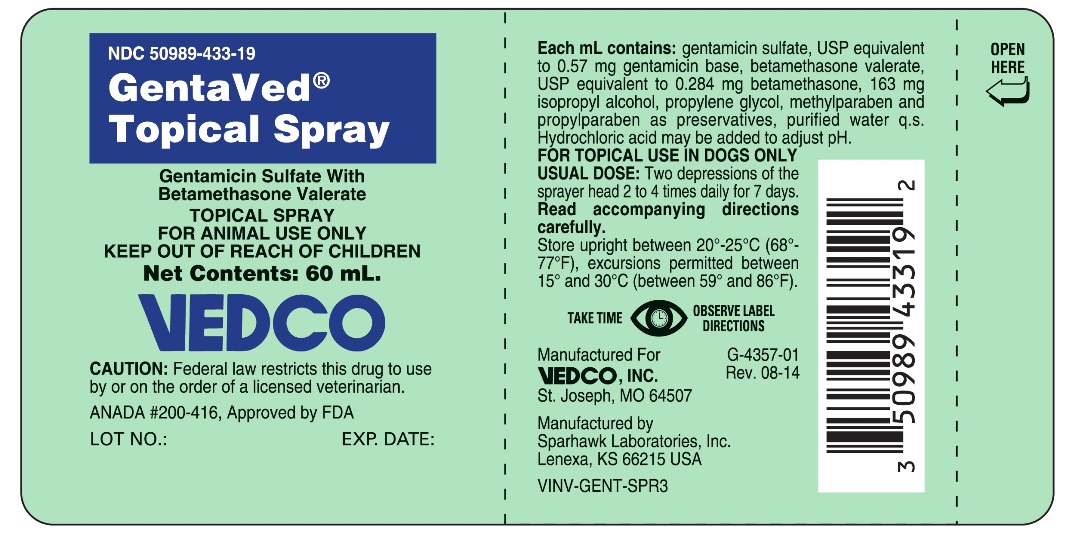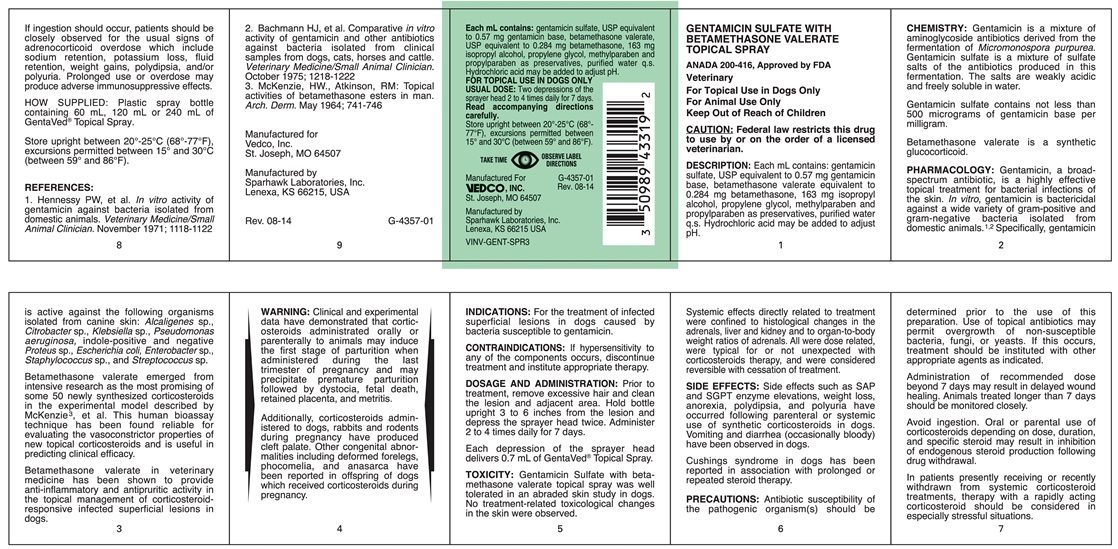GentaVed Dailymed
Generic: gentamicin sulfate is used for the treatment of Dermatitis, Atopic Facial Dermatoses Foot Dermatoses Hand Dermatoses Inflammation Leg Dermatoses Mycoses Pruritus Ani Psoriasis Scalp Dermatoses Dermatitis, Seborrheic Purpura, Thrombocytopenic, Idiopathic Bone Diseases, Infectious Central Nervous System Infections Endocarditis Endocarditis, Bacterial Escherichia coli Infections Hypersensitivity Klebsiella Infections Proteus Infections Pseudomonas Infections Respiratory Tract Infections Staphylococcal Infections Peritonitis, Tuberculous Urinary Tract Infections Eye Infections, Bacterial Serratia Infections Skin Diseases, Bacterial Soft Tissue Infections Sepsis
Go PRO for all pill images
Description Section
GENTAMICIN SULFATE WITH BETAMETHASONE VALERATE  TOPICAL SPRAY
ANADA 200-416, Approved by FDA
For Topical Use in Dogs Only
For Animal Use Only
Keep Out of Reach of Children
CAUTION : Federal law restricts this drug to use by or on the order of a licensed veterinarian.
DESCRIPTION
Each mL contains: gentamicin sulfate, USP equivalent to 0.57 mg gentamicin base, betamethasone valerate equivalent to 0.284 mg betamethasone, 163 mg isopropyl alcohol, isopropyl alcohol, propylene glycol, methylparaben and propylparaben as preservatives, purified water q.s. Hydrochloric acid may be added to adjust pH.
Clinical Pharmacology Section
CHEMISTRY
Gentamicin is a mixture of aminoglycoside antibiotics derived from the fermentation of┬áMicromonospora purpurea´╗┐. Gentamicin sulfate is a mixture of sulfate salts of the antibiotics produced in this fermentation. The salts are weakly acidic and freely soluble in water.┬á┬á
Gentamicin sulfate contains not less than 500 micrograms of gentamicin base per milligram.
Betamethasone valerate is a synthetic glucocorticoid.
PHARMACOLOGY
Gentamicin, a broad-spectrum antibiotic, is a highly effective topical treatment for bacterial infections of the skin. In vitro, gentamicin is bactericidal against a wide variety of gram-positive and gram-negative bacteria isolated from domestic animals.1,2 Specifically, gentamicin is active against the following organisms isolated from canine skin: Alcaligenes sp., Citrobacter sp., Klebsiella sp., Pseudomonas aeruginosa, indole-positive and negative Proteus sp., Escherichia coli, Enterobacter sp., Staphylococcus sp., and Streptococcus sp. 
Betamethasone valerate emerged from intensive research as the most promising of some 50 newly synthesized corticosteroids in the experimental model described by McKenzie3, et al. This human bioassay technique has been found reliable for evaluating the vasoconstrictor properties of new topical corticosteroids and is useful in predicting clinical efficacy.
Betamethasone valerate in veterinary medicine has been shown to provide anti-inflammatory and antipruritic activity in the topical management of corticosteroid-responsive infected superficial lesions in dogs.
Warnings
Clinical and experimental data have demonstrated that corticosteriods administrated orally or parenterally to animals may induce the first stage of parturition when administered during the last trimester of pregnancy and may precipitate premature parturition followed by dystocia, fetal death, retained placenta, and metritis.
Additionally, corticosteroids administered to dogs, rabbits and rodents during pregnancy have produced cleft palate. Other congenital abnormalities including deformed forelegs, phocomelia, and anasarca have been reported in offspring of dogs which received corticosteroids during pregnancy.
Indications
For the treatment of infected superficial lesions in dogs caused by bacteria susceptible to gentamicin.
Contraindications
If hypersensitivity to any of the components occurs, discontinue treatment and institute appropriate therapy.
Dosage And Administration
Prior to treatment, remove excessive hair and clean the lesion and adjacent area. Hold bottle upright 3 to 6 inches from the lesion and depress the sprayer head twice. Administer 2 to 4 times daily for 7 days.
Each depression of the sprayer head delivers 0.7 mL of GentaVed Topical Spray.
Toxicity
Gentamicin Sulfate with betamethasone valerate topical spray was well tolerated in a abraded skin study in dogs. No treatment-related toxicological changes in the skin were observed.
Systemic effects directly related to treatment were confined to histological changes in the adrenals, liver and kidney and to organ-to-body weight ratios of adrenals. All were dose related, were typical for or not unexpected with corticosteroids therapy, and were considered reversible with cessation of treatment.
Side Effects
Side effects such as SAP and SGPT enzyme elevations, weight loss, anorexia, polydipsia, and polyuria have occurred following parenteral or systemic use of synthetic corticosteroids in dogs. Vomiting and diarrhea (occasionally bloody) have been observed in dogs.
Cushings syndrome in dogs has been reported in association with prolonged or repeated steroid therapy.
Precautions
Antibiotic susceptibility of the pathogenic organism(s) should be determined prior to the use of this preparation. Use of topical antibiotics may permit overgrowth of non-susceptible bacteria, fungi, or yeasts. If this occurs, treatment should be instituted with other appropriate agents as indicated. 
Administration of recommended dose beyond 7 days may result in delayed wound healing. Animals treated longer than 7 days should be monitored closely.
Avoid ingestion. Oral or parental use of corticosteroids depending on dose, duration, and specific steroid may result in inhibition of endogenous steroid production following drug withdrawal. 
In patients presently receiving or recently withdrawn from systemic corticosteroid treatments, therapy with a rapidly acting corticosteroid should be considered in especially stressful situations.
If ingestion should occur, patients should be closely observed for the usual signs of adrenocorticoid overdose which includes sodium retention, potassium loss, fluid retention, weight gains, polydipsia, and/or polyuria. Prolonged use or overdose may produce adverse immunosuppressive effects.
How Supplied
Plastic spray bottle containing 60 mL, 120 mL, or 240 mL of GentaVed Topical Spray.
Storage And Handling Section
Store upright between 20o-25oC (68o-77oF), excursions permitted between 15o and 30o (between 59o and 86oF).
TAKE TIME OBSERVE LABEL DIRECTIONS.
References
1.┬á Hennessy PW, et al.┬á´╗┐In vitro´╗┐ activity of gentamicin against bacteria isolated from domestic animals.┬á´╗┐Veterinary Medicine/Small Animal Clinician.´╗┐ November 1971; 1118-1122
2.┬á Bachmann HJ, et al. Comparative┬á´╗┐in vitro´╗┐ activity of gentamicin and other antibiotics against bacteria isolated from clinical samples from dogs, cats, horses and cattle.┬á´╗┐Veterinary Medicine/Small Animal Clinician´╗┐. October 1975; 1218-1222
3.┬á McKenzie, HW., Atkinson, RM: Topical activities of betamethasone esters in man.┬á´╗┐Arch. Derm.┬á´╗┐May 1964; 741-746
Package Label.principal Display Panel
DISCLAIMER:
"This tool does not provide medical advice, and is for informational and educational purposes only, and is not a substitute for professional medical advice, treatment or diagnosis. Call your doctor to receive medical advice. If you think you may have a medical emergency, please dial 911."
"Do not rely on openFDA to make decisions regarding medical care. While we make every effort to ensure that data is accurate, you should assume all results are unvalidated. We may limit or otherwise restrict your access to the API in line with our Terms of Service."
"This product uses publicly available data from the U.S. National Library of Medicine (NLM), National Institutes of Health, Department of Health and Human Services; NLM is not responsible for the product and does not endorse or recommend this or any other product."
PillSync may earn a commission via links on our site



